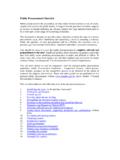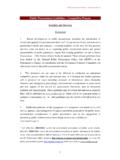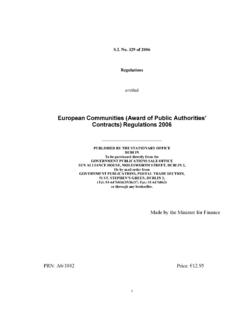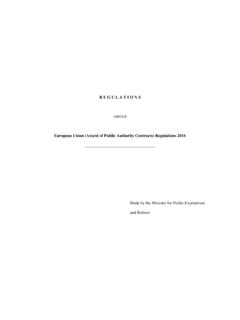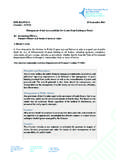Transcription of Circular 10/10: Facilitating SME Participation in Public ...
1 Ref: S9/24/07. 13 August 2010. To Heads of Departments / Offices1. Circular 10/10: Facilitating SME Participation in Public procurement A Dhuine Uasail, 1. The Government recognises that the small and medium enterprise (SME) sector is very important to the economy and that Public procurement can be an important source of business for SMEs. The Cabinet Committee on Transforming the Public Service recently considered issues that face SMEs in the Public procurement market. In the present economic climate, the competition for Public contracts has intensified and some SMEs are finding it more difficult to win such business. In these circumstances, it is particularly important that small and medium sized businesses are not hindered in competing for contracts that they could perform effectively. New Guidance 2. In this context, the Minister for Finance has decided to issue guidance to Public contracting authorities aimed at their structuring competitive processes for Public contracts in a manner that facilitates increased Participation by SMEs, while they continue to ensure that all Public sector purchasing is carried out in a manner that is legal, transparent, and secures optimal value for money for the taxpayer.
2 3. Two guidance documents are issuing with this Circular . The first document is entitled Guidance for Contracting Authorities: Facilitating Participation of SMEs in Public procurement and it sets out principles and approaches for Public procurement generally. 2 The second document relates specifically to the procurement by Public contracting authorities of works and works contractors'. 4. The guidance sets out positive measures that contracting authorities are required to take to promote SME involvement in a manner that is consistent with the principles and rules of the existing Public procurement regulatory regime. The guidance also highlights practices that are to be avoided because they can unjustifiably hinder small businesses in competing for Public contracts. 1. In this letter, the term Department encompasses Departments and Offices. 2. Available also on-line at document 26. 3. Available also on-line at , GN 2.
3 5. In addition to clarifying certain aspects of procurement policy and highlighting existing mechanisms that should be used by contracting authorities to improve market openness and reduce barriers to entry, the guidance documents contain some new or revised measures. These will be kept under review in the light of the impact on operational efficiency and value for money. In summary, some of the key features (which are set out in detail in the guidance) are . - contracts for supplies and general services with an estimated value of 25,000 or more are now to be advertised on the website. Previously only contracts above 50,000 were required to be advertised in this way. The advertising threshold for works and related services4 remains at 50,000. As before, contracting authorities are encouraged to advertise contracts of lower value also where this would be useful. - new arrangements are being introduced whereby advertised contracts below a certain threshold must be awarded under an open procedure ( without pre-qualification of tenderers).
4 The threshold is 125,000 in the case of advertised contracts for supplies and general services and 250,000 in the case of advertised contracts for works and related services. This measure is aimed at improving the openness of the competitive process. - much of the documentary evidence of a tenderer's capacity to undertake a project should no longer to be sought by the contracting authority early on in the tendering process. Instead, tenderers should be asked to declare that they have the necessary capacity and that they will be in a position to produce the necessary documentation when requested. That documentary evidence ( bank statements, audited accounts, proof of professional indemnity, etc.) need only be produced when a tenderer has been short-listed or is coming under consideration for the award of a contract. This approach is aimed at reducing the up-front administrative burden for businesses that are interested in tendering for contracts.
5 - contracting authorities are strongly reminded that the levels they set for suitability criteria (especially in relation to a potential tenderer's turnover levels) must be both justifiable and proportionate to the needs of the contract. In the case of contracts for works and related services, further specific guidance on this matter is being developed and is scheduled to issue in September 2010. National procurement Service 6. Contracting authorities are reminded of the role of the National procurement Service which was established in 2009 by the Government within the Office of Public Works. The NPS is working closely with all areas of the Public sector to promote efficiencies and economies in contracting for supplies and general services. All contracting authorities are strongly encouraged to engage fully with the NPS in its various initiatives to improve the Public procurement function across the Public sector, including measures to enhance competition and improve the access of SMEs to Public procurement opportunities.
6 4. This means contracts for works, contracts for works contractors' services ( project supervisor for construction stage) and contracts for works-related professional services ( professional construction design services). 3. Dissemination and Implementation of Guidance 7. You are requested to bring this Circular and accompanying guidance documents to the attention of . (i) all staff in your Department who are involved in any aspect of procurement , and (ii) all contracting authorities under the aegis of your Department, and to ensure that arrangements are put in place so as to ensure and monitor its implementation in all the areas under the aegis of your Department. Enquiries 8. Enquiries in regard to this Circular and the accompanying guidance can be addressed to the following: Enquiry related to: Organisation Contact Details National procurement Operational issues for Telephone: (046) 9426000. Service, supplies and services E-mail: Office of Public Works Construction policy issues Telephone: (01) 6045669.
7 National Public procurement E-mail: and Policy Unit, General procurement policy Department of Finance Telephone: (01) 6045667. issues E mail : 9. Further guidance is being developed on standardised documentation (including model forms of contract for supplies and services) and in relation to setting minimum standards for works and related services and these will be issued shortly. Mise le meas, Robert Watt Assistant Secretary 4. Guidance for Public Contracting Authorities: Facilitating the Participation of SMEs in Public procurement 5. 1. Introduction The Government recognises that the small and medium enterprise (SME) sector is very important to the economy and that Public procurement can be an important source of business for SMEs. The Cabinet Committee on Transforming the Public Service recently considered issues that face SMEs in the Public procurement market. In the present economic climate, the competition for Public contracts has intensified and some SMEs are finding it more difficult to win such business.
8 In these circumstances, it is particularly important that small and medium sized businesses are not hindered in competing for contracts that they could perform effectively. The National Public procurement Policy Unit (NPPPU) in the Department of Finance promotes and supports policies which facilitate SME Participation as much as possible. The National procurement Service (NPS) in the Office of Public Works was established in 2009 and acts as a centre of excellence providing advice on and implementing procurement policy in line with best practice and Government initiatives, including improved access to Public procurement opportunities for SMEs. The purpose of this new guidance6 is to restate existing policy and measures and to introduce some new or revised measures relevant to Facilitating SME Participation in Public procurement markets;. the aim is to have contracting authorities structure and run their competitive processes for Public contracts in a manner that facilitates increased Participation by SMEs, while they continue to ensure that all Public sector purchasing is carried out in a manner that is legal, transparent, and secures optimal value for money for the taxpayer.
9 This guidance is not designed to favour the SME sector over other sectors but rather to provide SMEs with a level playing field in competing for Public contracts. This is in line with EU policy on increased SME Participation in Public procurement . 7 The aim is to create markets that have multiple suppliers; this should lead to more competition and improved value for money while maintaining the basic EU Treaty principles of openness and transparency in the market. At all times, this guidance is to be implemented by contracting authorities in accordance with the principles of EU law, and in a manner that is fully compliant with EC Public procurement law and national guidelines. In the event of any ambiguity between this document and the provisions of the Capital Works Management Framework, the latter takes precedence, where applicable. 5. This guidance is issued with Circular 10/10. It is available also on-line at (document 26).
10 6. Specific guidance in relation to contracts for works and related services is also issued under Circular 10/10. It is available also on-line at: 7. European Code of best practices Facilitating access by SMEs to Public procurement contracts , Brussels: 2008. Available on-line at: 5. 2. Use of eTenders Website The Public procurement website (eTenders) is a national resource available to both contracting authorities and suppliers which increases transparency and greatly facilitates access to Public sector contracts. (i) Advertising Until now, the existing guidelines required contracting authorities to advertise supplies and service contracts with estimated values of more than 50,000 on the national Public procurement website in the normal course. This provision was recently extended to include works contracts. Some authorities advertise contracts of less than this value (ranging from 10,000 upwards) as standard practice.


